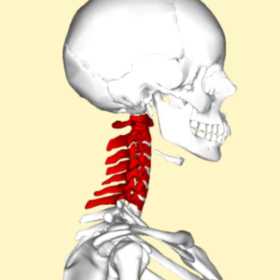Do you require any assistance? Simply reserve your appointment online below
Cervical Disk Degeneration (Spondylosis)
Remarkable healing experience for you
The disk acts as a shock absorber between the bones in the neck. In cervical disk degeneration, the normal gelatin-like center of the disk degenerates and the space between the vertebrae narrows.
As the disk space narrows, added stress is applied to the joints of the spine causing further wear and degenerative disease.
The cervical disk may also protrude and put pressure on the spinal cord or nerve roots when the rim of the disk weakens.

Causes of Spondylosis

The disk acts as a shock absorber between the bones in the neck. In cervical disk degeneration, the normal gelatin-like center of the disk degenerates and the space between the vertebrae narrows.
As the disk space narrows, added stress is applied to the joints of the spine causing further wear and degenerative disease. The cervical disk may also protrude and put pressure on the spinal cord or nerve roots when the rim of the disk weakens.
Symptoms of Spondylosis
Pain from spondylosis starts in the center of the lower back and radiates downward.
In many cases, patients with spondylosis do not have any obvious symptoms.
The conditions may not even be discovered until an x-ray is taken for an unrelated injury or condition.
When symptoms do occur, the most common symptom is lower back pain.
This pain may:
Feel similar to a muscle strain
Radiate to the buttocks and back of the thighs
Worsen with activity and improve with rest
Treatment of Spondyliosis/ Cervical disc degeneration
There is no treatment to reverse the process of spondylosis, because it is a degenerative process. The treatments for spondylosis target the back pain and neck pain that spondylosis can cause. Therefore, the treatment of spondylosis is similar to the treatment of back pain and neck pain.
Available treatments fall into several categories: medications, self-care, exercise and physical therapy, adjunctive therapies (chiropractics and acupuncture), minimally invasive procedures such as injections, and surgery.
Initial treatment is almost always non surgical in nature. Most patients with spondylolysis will improve with nonsurgical treatment.
The goals of treatment for spondylosis is to:
- Reduce pain
- Allow a recent pars fracture to heal
- Return the patient to sports and other daily activities

You are in Great Hands
Non surgical Treatment of Spondyliosis

Rest. Avoid sports and other activities that place excessive stress on the lower back.
Nonsteroidal anti-inflammatory drugs. NSAIDs such as ibuprofen and naproxen can help reduce swelling and relieve back pain.
Physical therapy. Specific exercises can help improve flexibility, stretch tight hamstring muscles, and strengthen muscles in the back and abdomen.
Corticosteroids. If your pain is severe, steroid injections may be helpful.
Muscle relaxants. Certain drugs, such as cyclobenzaprine, can help relieve muscle spasms in the neck..
Bracing. Some patients may need to wear a back brace for a period of time to limit movement in the spine and provide an opportunity for a recent pars fracture to heal. Over the course of treatment, your doctor will take periodic x-rays to determine whether the vertebra is changing position.
Anti-seizure medications. Some epilepsy medications, such as gabapentin (Neurontin, Horizant) and pregabalin (Lyrica), can dull the pain of damaged nerves.
Antidepressants. Certain antidepressant medications have been found to help ease neck pain from cervical spondylosis

When to seek medical Care
If severe neck pain occurs following an injury, a trained professional, such as a paramedic, should immobilize the patient to avoid the risk of further injury and possible paralysis. Medical care should be sought immediately.
Immediate medical care should also be sought when an injury causes pain in the neck that radiates down the arms and legs. Radiating pain or numbness in your arms or legs causing weakness in the arms or legs without significant neck pain should also be evaluated. If there has not been an injury, you should seek medical care when neck pain is:
- Continuous and persistent
- Severe
- Accompanied by pain that radiates down the arms or legs
- Accompanied by headaches, numbness, tingling, or weakness
Many patients seek orthopaedic care for neck pain because orthopaedists are specifically trained to diagnose, treat, and help prevent problems involving the muscles, bones, joints, ligaments, and tendons.
